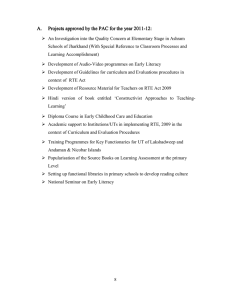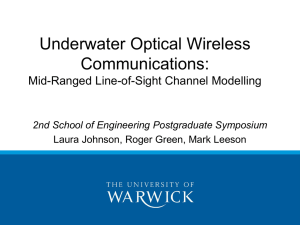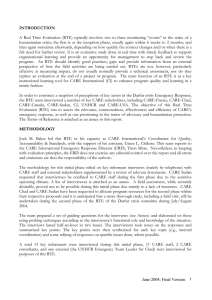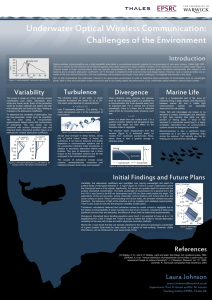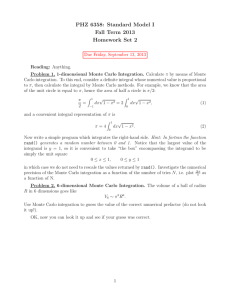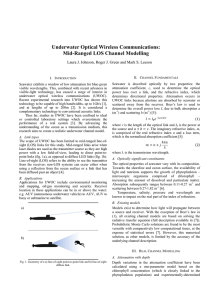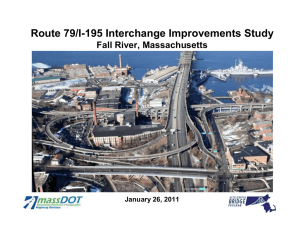A Survey of Channel Models for Underwater Optical Wireless Communication IWOW 2013
advertisement
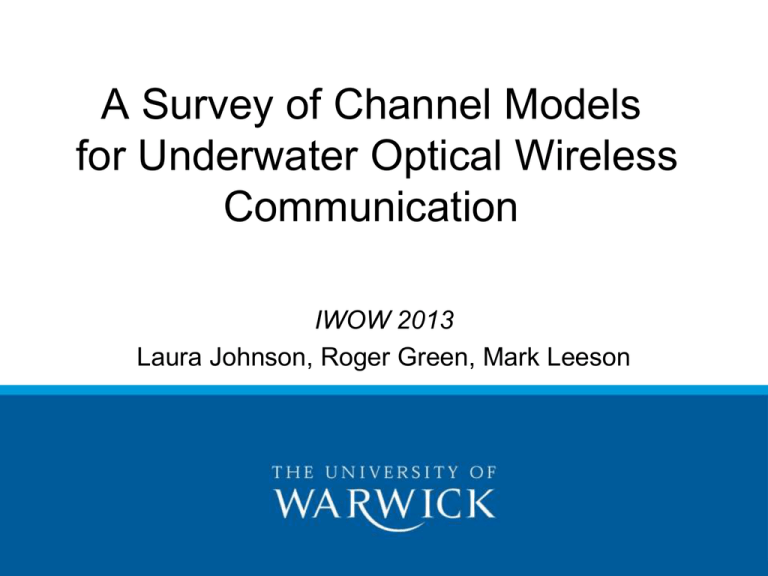
A Survey of Channel Models for Underwater Optical Wireless Communication IWOW 2013 Laura Johnson, Roger Green, Mark Leeson Overview • • • • • • • Motivation Underwater channel fundamentals Natural waters Criteria for models Assessment of models Summary of findings Conclusion 2 Motivation • Lowered attenuation for visible wavelengths • Short- to mid-ranged market visible band 106 Attenuation coefficient (m-1) 10-2 -14 10 10-10 10-6 10-2 • Defining real world scenarios 102 106 3 Underwater Channel Fundamentals Compared to free-space: • Generally higher attenuation • Only 1 transmission window • Greater variability 4 Natural Waters: Composition Variability 1 2 3 Image: Google Earth (accessed 25/09/13) 5 Natural Waters: Composition Variability • Organic composition linked to chlorophyll concentration. • Chlorophyll varies with: – time, – laterally, – with depth. attenuation coefficient (m-1) 0 0.1 0.2 0 -50 ocean -100 depth (m) -150 -200 -250 6 Natural Waters: Refractive Variability refractive index 1.341 1.344 1.347 0 200 ocean 400 depth (m) 600 • Fluctuations: – Small-medium, (scattering) – Large (turbulence). • Gradient with depth 800 1000 7 Criteria for Models A. Ability to model: – varying composition and refractive index with depth, – localised turbulence, – sunlight at the receiver. B. Gives information about: power reduction, spatial light distribution, temporal distribution. C: Simplicity, ease of use 8 Assessment of Modelling Schemes • Qualitative study due to nature of schemes • The modelling schemes of interest: - Beer’s Law - Radiative transfer equation - Approximate analytical solution of the RTE - Numerical solutions (Monte Carlo, Discrete ordinates, imbedding invariants) 9 Summary of Findings A. Ability to model: – Varying composition and refractive index with depth. All capable (no orientation issues for Monte Carlo and RTE) – Localised turbulence RTE and solutions – Sunlight at the receiver RTE and solutions (orientation issues) 10 Summary of Findings B. Gives information about: – power reduction, all show – Spatial, RTE and solutions – Temporal RTE and numerical solutions C. Simplicity, ease of use – Beer’s law is simplest – RTE most complex, cannot be solved – Numerical solutions are a compromise 11 Conclusion • Monte Carlo most fit for purpose – Relatively simple scheme to describe complex situations – Works at any orientation • Resulting work – Modelling in mid-ranged ocean links – “Monte Carlo Simulation for Underwater Optical Wireless Communications” (Poster session) 12 Any Questions? E-mail: laura.j.johnson@warwick.ac.uk 13
